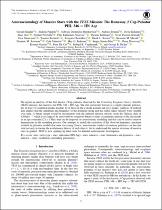| dc.description.abstract | We report an analysis of the first known β Cep pulsator observed by the Transiting Exoplanet Survey Satellite (TESS) mission, the runaway star PHL 346 = HN Aqr. The star, previously known as a singly periodic pulsator, has at least 34 oscillation modes excited, 12 of those in the g-mode domain and 22 p modes. Analysis of archival data implies that the amplitude and frequency of the dominant mode and the stellar radial velocity were variable over time. A binary nature would be inconsistent with the inferred ejection velocity from the Galactic disk of 420 km s−1 which is too large to be survivable by a runaway binary system. A kinematic analysis of the star results in an age constraint (23 ± 1 Myr) that can be imposed on asteroseismic modeling and that can be used to remove degeneracies in the modeling process. Our attempts to match the excitation of the observed frequency spectrum resulted in pulsation models that were too young. | en_US |

